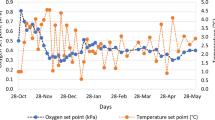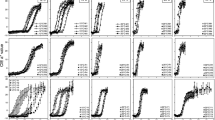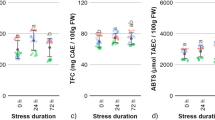Abstract
As long ago as 1924 Kidd1 produced a “progress curve of fungal invasion” which was used by her and co-workers2,3 for assessing the storage life of apples. Similar curves have been obtained by workers in the Division of Food Preservation, Commonwealth Scientific and Industrial Research Organization, for the development of physiological disorders in cool stored fruits (Fig. 1). We have found this relationship may be made linear, in each case, by transforming percentage disorder to a probit4 and storage time to a logarithm (Fig. 2). In addition to the advantage of linearity for calculating estimates, this transformation shows storage life is log normally distributed. Since such a distribution has a wide occurrence it is probable that it will apply to other disorders.
This is a preview of subscription content, access via your institution
Access options
Subscribe to this journal
Receive 51 print issues and online access
$199.00 per year
only $3.90 per issue
Buy this article
- Purchase on Springer Link
- Instant access to full article PDF
Prices may be subject to local taxes which are calculated during checkout
Similar content being viewed by others
References
Kidd, M. N., Rep. Food Invest. Board, 1924, 43.
Kidd, F., and West, C., Rep. Food Invest. Board, 1925, 1926
Kidd, F., West, C., and Kidd, M. N., Food Invest. Board Spec. Rep. No. 30 (1927).
Finney, D. J., Probit Analysis, second ed., 318 (Camb. Univ. Press, 1952).
Author information
Authors and Affiliations
Rights and permissions
About this article
Cite this article
ROBERTS, E., SCOTT, K. Estimation of Storage Life of Fruits. Nature 195, 824–825 (1962). https://doi.org/10.1038/195824a0
Issue Date:
DOI: https://doi.org/10.1038/195824a0
Comments
By submitting a comment you agree to abide by our Terms and Community Guidelines. If you find something abusive or that does not comply with our terms or guidelines please flag it as inappropriate.



